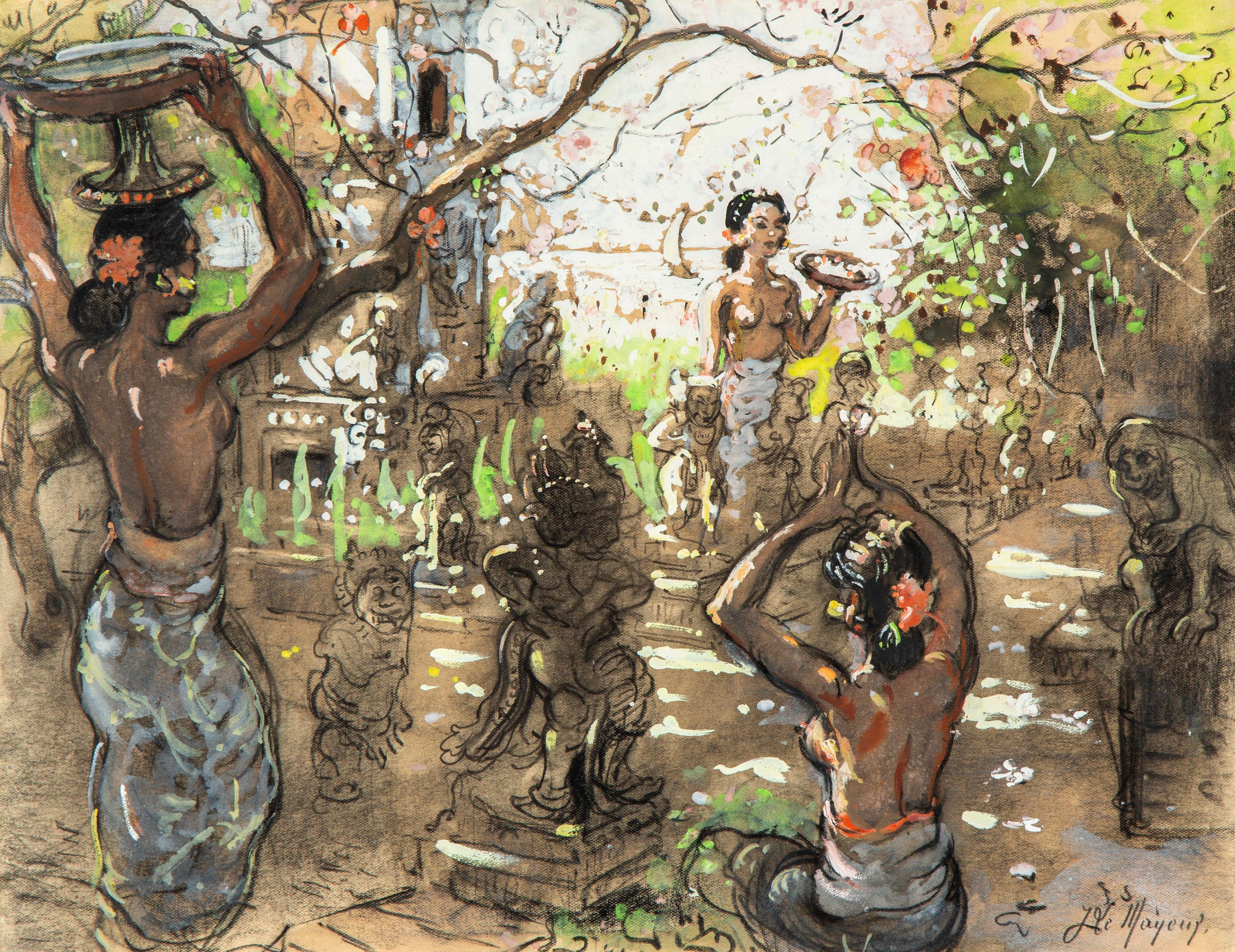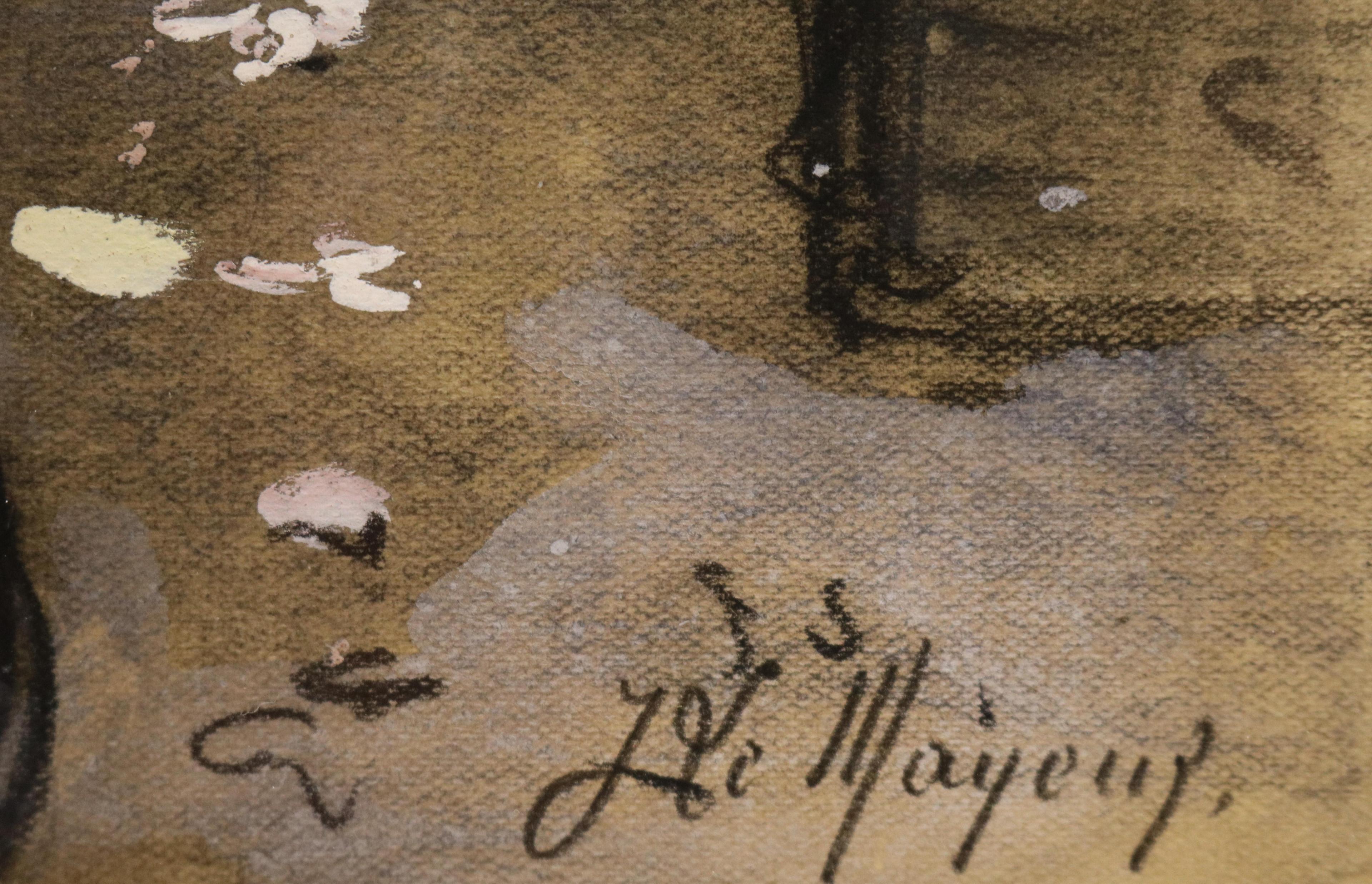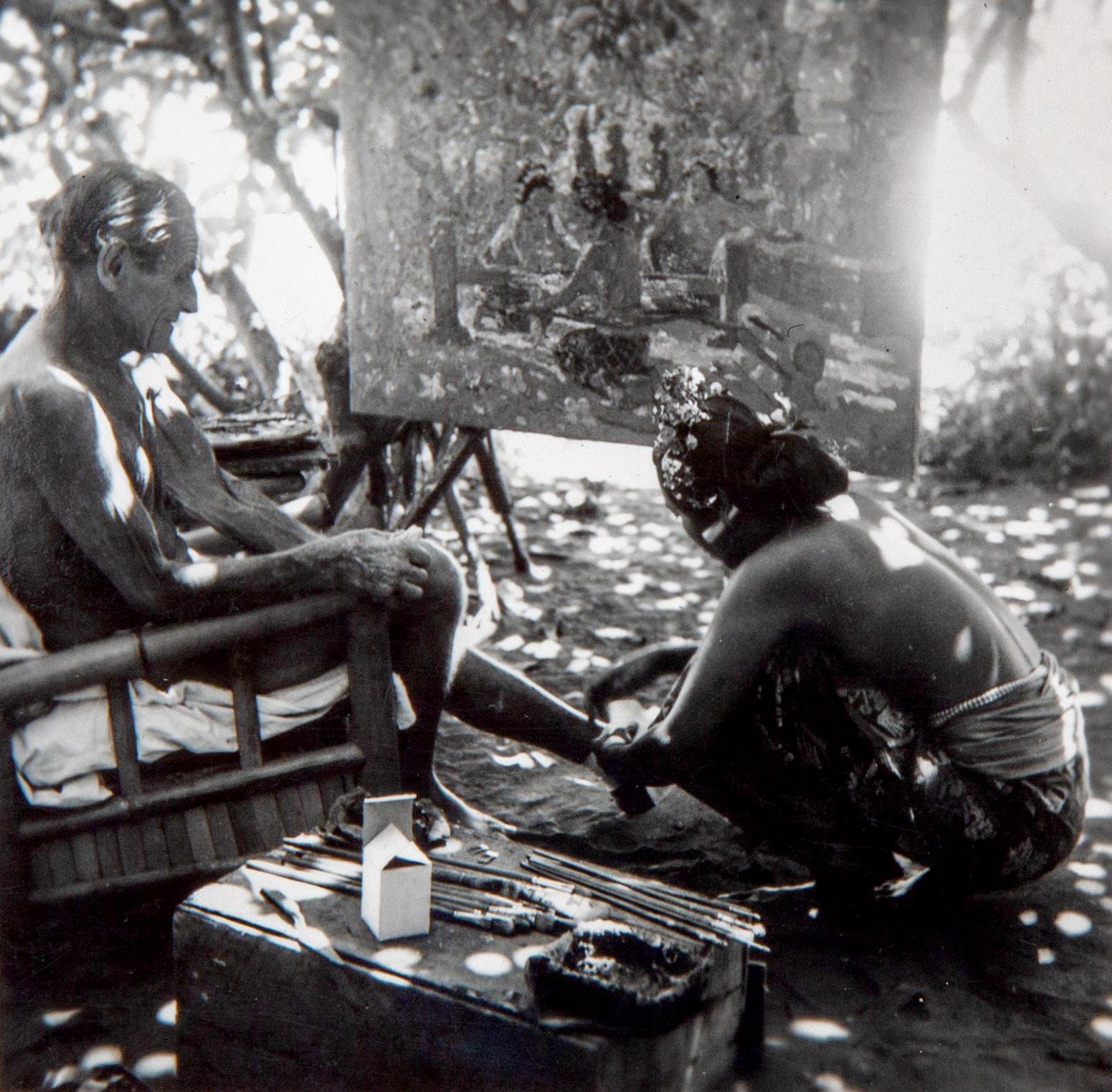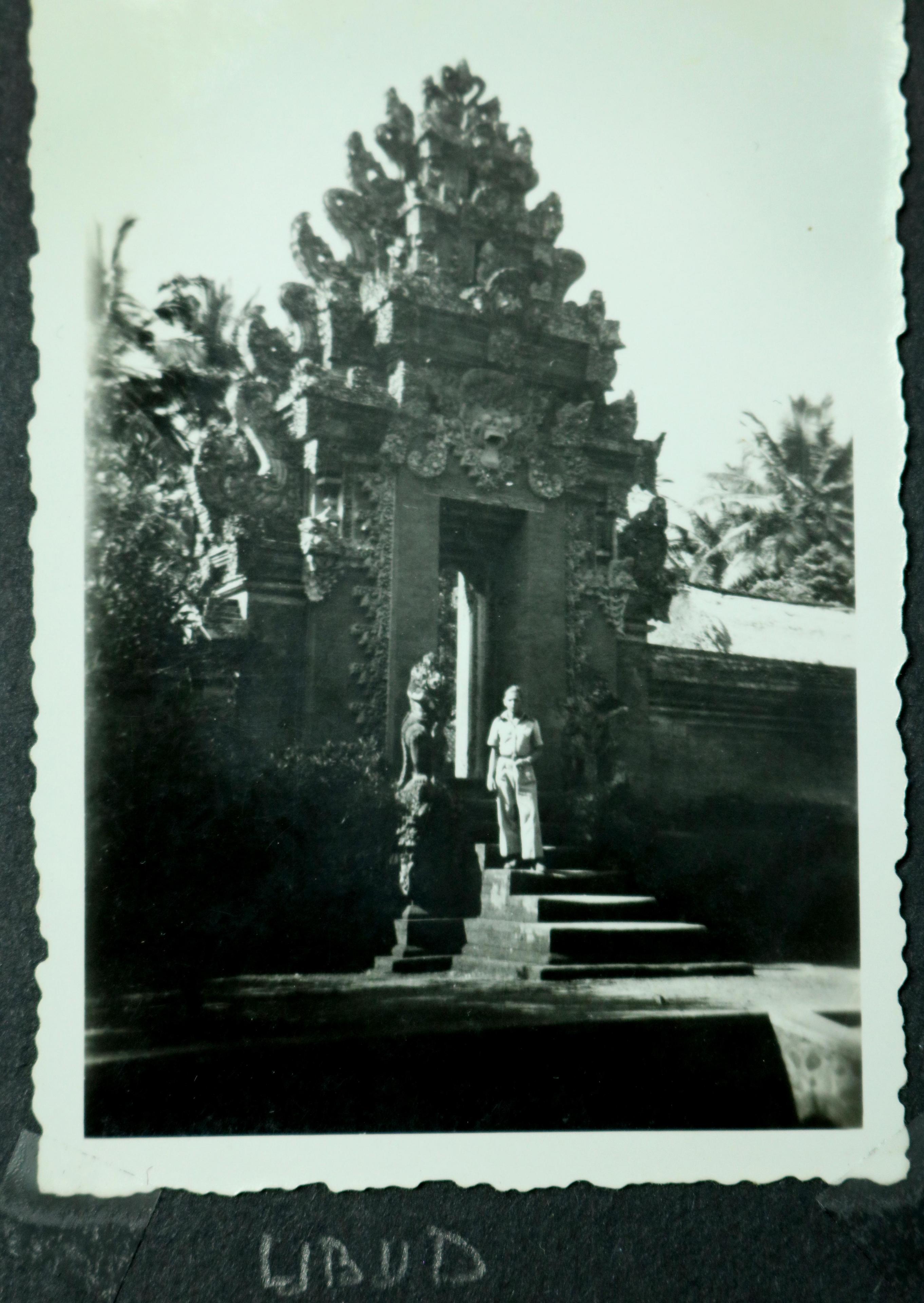
Beschrijving
Signed 'J. Le Mayeur' (lower right), heightened in white. Provenance: -Harry Dijkman (1920-1994), thence by descent to the present owner.
In this auction of Venduehuis Auctioneers the lots 138, 139, 140 and 141 belonged to the collection of the late Harry Dijkman, an Indo-European captain from the KNIL. During the Second World War he was put to work on the Burma railway line by the Japanese. After the capitulation by Japan in 1945 he was seconded to the KNIL on Bali.
Besides his work he also had a great interest in the Balinese culture. He and his wife, Fieneke Mes became friendly with Le Mayeur and his muze, Ni Pollok, visiting them often and where they acquired this work (lot 138). Whilst Dijkman was in Bali, he also purchased three sculptures by the sculptor Ida Bagoes Nyana (lots 138, 139 and 140). Dijkman later emigrated to the United States and worked at the university of Berkeley, California as a technical photographer.
Born in 1880 in Belgium from a wealthy noble family, Le Mayeur’s curiousity about Bali was aroused when in Tahiti he saw a film about this island. After his first brief visit late in 1929, the ‘island of gods’ was to leave an indelible impression on him. He went back in 1932. Bali was to become a rich source of inspiration for Le Mayeur. He devoted himself to the task of depicting his immediate surroundings: the Balinese people, the luxuriant flora, the beach, the sea, usually bathed in exuberant sunlight.
Only in a brief period of time he had enough works for a first exhibition, in Singapore. The reviewers were unanimous in their praise of Le Mayeur and his work. They write: ‘With the Bali girls as subject, he has succeeded in capturing the sunny spirit of subject and scene. His technique is simple but effective, he indicates every essential without going into detail. His colouring is brilliantly effective, and he captures the brightness and colourfulness of the tropical scene with the minimum of effort’. Most of the purchasers were Europeans and Americans, some inhabitants of Singapore.
Le Mayeur prefers to take his easel out into the light and air rather than to work in a studio, making his work exhale the rich breath of the tropical exterior. In a post-war interview Le Mayeur describes why he never left the island: ‘Why should I? I am an impressionist. There are three things in life I love: beauty, sunlight and silence. Tell me where to find these in a more perfect state than in Bali?’. In 1935 he married his favourite model Ni Wayan Pollok Tjoeglik, also known as Ni Pollok. He bought a cottage by Sanur beach, and created a perfect environment for his art to florish: a sun drenched tropical house with a lush garden. In this little world he had created on a few square metres of beach, separating the endless space of ocean from a huge ricefield and palm forest, he was perfectly happy. He found all his themes in the immediate proximity of his home.
After the Second World War Le Mayeur started frenetically to paint again. In this lot 138 the scenery is none other than Le Mayeur’s backyard. We see three elegant Balinese women placed under a tree branch with flowers and leaves. Spaciousness is heightened by the inclusion of the seascape with a boat in the background. He thus created a vista. His palette is bright as ever.
Source: J. Ubbens, Jop, C. Huizing, ‘Adrien Jean le Mayeur de Merprés, Painter-Traveller / Schilder-reiziger’, Wijk en Aalburg, 1995.
Photo illustrations: Harry Dijkman at a temple gate, Bali
Adrien-Jean Le Mayeur de Merprès and his wife Ni Pollok (both photos taken from Harry Dijkman’s private photo collection).
The sunny garden in Sanur with Ni Pollok and Balinese maidens
Mayeur De Merpres, Adrien Jean Le
(Elsene, 1880
-
Brussel,
1958)
Details
- Databanknummer:
- 85563
- Lotnummer:
- -
- Advertentietype
- Archief
- Instelling:
- Venduehuis Den Haag
- Veilingdatum:
- -
- Veilingnummer:
- -
- Stad
- -
- Limietprijs
- -
- Aankoopprijs
- -
- Verkoopprijs
- -
- Hamerprijs
- -
- Status
- Verkocht
Technische details
- Kunstvorm:
- Schilder- en Tekenkunst
- Technieken:
- Gouache, Houtskool
- Dragers:
- Papier
- Lengte:
- 28 cm
- Breedte:
- 36.5 cm
- Hoogte:
- -
- Oplage:
- -
Beschrijving
Signed 'J. Le Mayeur' (lower right), heightened in white. Provenance: -Harry Dijkman (1920-1994), thence by descent to the present owner.
In this auction of Venduehuis Auctioneers the lots 138, 139, 140 and 141 belonged to the collection of the late Harry Dijkman, an Indo-European captain from the KNIL. During the Second World War he was put to work on the Burma railway line by the Japanese. After the capitulation by Japan in 1945 he was seconded to the KNIL on Bali.
Besides his work he also had a great interest in the Balinese culture. He and his wife, Fieneke Mes became friendly with Le Mayeur and his muze, Ni Pollok, visiting them often and where they acquired this work (lot 138). Whilst Dijkman was in Bali, he also purchased three sculptures by the sculptor Ida Bagoes Nyana (lots 138, 139 and 140). Dijkman later emigrated to the United States and worked at the university of Berkeley, California as a technical photographer.
Born in 1880 in Belgium from a wealthy noble family, Le Mayeur’s curiousity about Bali was aroused when in Tahiti he saw a film about this island. After his first brief visit late in 1929, the ‘island of gods’ was to leave an indelible impression on him. He went back in 1932. Bali was to become a rich source of inspiration for Le Mayeur. He devoted himself to the task of depicting his immediate surroundings: the Balinese people, the luxuriant flora, the beach, the sea, usually bathed in exuberant sunlight.
Only in a brief period of time he had enough works for a first exhibition, in Singapore. The reviewers were unanimous in their praise of Le Mayeur and his work. They write: ‘With the Bali girls as subject, he has succeeded in capturing the sunny spirit of subject and scene. His technique is simple but effective, he indicates every essential without going into detail. His colouring is brilliantly effective, and he captures the brightness and colourfulness of the tropical scene with the minimum of effort’. Most of the purchasers were Europeans and Americans, some inhabitants of Singapore.
Le Mayeur prefers to take his easel out into the light and air rather than to work in a studio, making his work exhale the rich breath of the tropical exterior. In a post-war interview Le Mayeur describes why he never left the island: ‘Why should I? I am an impressionist. There are three things in life I love: beauty, sunlight and silence. Tell me where to find these in a more perfect state than in Bali?’. In 1935 he married his favourite model Ni Wayan Pollok Tjoeglik, also known as Ni Pollok. He bought a cottage by Sanur beach, and created a perfect environment for his art to florish: a sun drenched tropical house with a lush garden. In this little world he had created on a few square metres of beach, separating the endless space of ocean from a huge ricefield and palm forest, he was perfectly happy. He found all his themes in the immediate proximity of his home.
After the Second World War Le Mayeur started frenetically to paint again. In this lot 138 the scenery is none other than Le Mayeur’s backyard. We see three elegant Balinese women placed under a tree branch with flowers and leaves. Spaciousness is heightened by the inclusion of the seascape with a boat in the background. He thus created a vista. His palette is bright as ever.
Source: J. Ubbens, Jop, C. Huizing, ‘Adrien Jean le Mayeur de Merprés, Painter-Traveller / Schilder-reiziger’, Wijk en Aalburg, 1995.
Photo illustrations: Harry Dijkman at a temple gate, Bali
Adrien-Jean Le Mayeur de Merprès and his wife Ni Pollok (both photos taken from Harry Dijkman’s private photo collection).
Geen prijsinformatie? Sluit een abonnement af.


